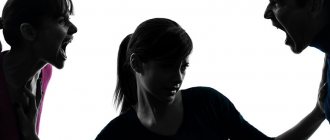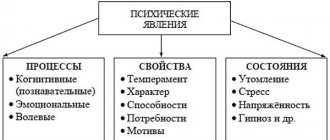Victimization is a person’s predisposition to be a victim. At the same time, there is a difference between social predisposition, where the likelihood of becoming a victim depends on the crime situation in the region, as well as psychological victimization, when characterological and personality traits acquired as a result of upbringing or psychological traumas received contribute to provoking behavior.
The victim's victimization due to psychological factors has been seriously criticized by many authors and is practically discredited in jurisprudence, where only one party bears responsibility for the crime committed. To prove this, facts are cited that the victim’s behavior is perceived as a provocation exclusively by the criminal and is not objective. That is why this concept is not used in court cases of murder and rape, but has a place in practical psychology. It makes sense to talk about victimization when a person has an increased likelihood of getting into trouble, which is caused by various internal reasons.
The concept of victimization in psychology
Some psychologists express the opinion that there is a special victim behavior. This behavioral model implies that a person constantly finds himself in the position of a victim, attracting rapists, maniacs and other people who like to make fun of him.
The concept of “victimization” first appeared in criminology. There is even a corresponding branch of criminology - victimology, which studies the process of becoming a victim of a crime. Subsequently, some psychotherapists armed themselves with this concept, who began to view victimization as a complex of pathological properties of a person who constantly finds himself in the position of a victim. Nowadays, this phenomenon is studied in various spheres of human life, but most of all in family relationships.
A person suffering from this “pathology” constantly finds himself in unpleasant situations in which he is harmed in some way. In this case, the cause of harm can be not only another person, but also anything: an animal, bad weather, a natural disaster, any unfortunate combination of circumstances.
Proponents of the existence of victimization may encounter objections, because it seems that they are blaming the victims for the misfortunes that happen to them: the notorious “it’s your own fault” argument. In reality this is not the case. The guilt of the criminal in the crime has not yet been canceled, as well as the accident in circumstances and the existence of natural disasters. It's just that some researchers have noticed certain patterns in terms of, for example, how criminals choose their victims or why some people attract the unhealthy attention of villains, while others do not.
Proponents of this phenomenon point out that victimization behavior is especially characteristic of adolescents. A person at this age is endowed with enormous ambitions and qualities - such as youthful maximalism; however, insufficient knowledge of life leads to the fact that, under the influence of his ambitions, he constantly finds himself in unpleasant situations. Dissatisfaction with the result gives rise to the desire to “take revenge,” which leads to new troubles - and so on.
It has been noticed that some people tend to enter into conflicts over the slightest issue, even when disagreements can be avoided. On the other hand, no one doubts that school hooligans choose a special type of classmates for their atrocities - physically weak, naive, vulnerable, stupid, stooped, with a mincing gait, etc. Such people behave “funny” and cannot give back.
Victimization Case Study
In order to understand under what circumstances an ordinary person becomes a victim of crime, it is necessary to conduct a number of studies.
Victimization and its degree are determined if total data on the number of all victims is available. This does not depend in any way on the severity of the crime, its outcome or the presence of other factors that provoked the incident.
Simply put, victimization is the totality of all cases in which an object suffered moral or physical damage.
In addition, thanks to the study of the degree of predisposition to becoming a victim, we can talk about such a concept as crime. If we draw parallels between the cause and effect of these phenomena, the conclusion suggests itself. The more victims, the higher the crime rate, which means that human destructiveness is actively developing as an element of the social life of society.
Victimization and its types
Since victimization is a complex set of behavioral acts, researchers identify a number of its types according to different parameters:
- According to the behavior of the victim: guilty and innocent. In the first case, the victim actually provokes the aggressor or deliberately ends up in a dangerous situation; in the second case, a person falls into the victim state by accident or does not deliberately provoke the aggressor. Example: in the first case, a group of people beat up a gopnik who himself threatened to attack them. In the second case, the gopnik himself “runs into” a person who looks physically weak.
- By number of victims: individual and mass. In the first case, one person becomes the victim; in the second - some kind of social group (for example, representatives of a certain nationality).
Process communication
To prove this, it is worth noting that these two phenomena are inextricably linked. Any action aimed at achieving the state of victim has its logical conclusion.
This means that at the moment when a person is attacked, regardless of what the outcome of the event was, he automatically acquires the status of a victim. In this case, the attack itself is victimization in the process concept. And the person against whom the crime was committed is the result.
That is why victimization is the process of influence of one event on another. The more crimes occur, the higher the risk of becoming a victim.
What is victimization behavior
We said above that the behavior of the victim may or may not provoke the criminal. Criminologists, however, distinguish two types of active victim behavior. In the first case, she actually provokes the attacker to commit a crime: she threatens, robs, strikes, etc. In the second case, the victim does not want to provoke anyone, but her actions somehow contribute to the activities of the criminal. For example, an incompetent doctor only aggravated the patient’s illness, and the patient (or one of his relatives) begins to take revenge.
Psychologists also distinguish such types of victim behavior as comfortable and emotionally unstable. In the first case, the person seems to consciously choose the role of the victim; often he even admires the presence of the rapist next to him, because he sees in him a “strong personality.” Such victims are usually timid, fearful and insecure people with low self-esteem; with all this, they are characterized by resentment towards the entire world around them, they constantly complain.
In the second case, a person tries to be a rapist himself: he starts a conflict, gets into a fight; Such people tend to offend and humiliate the weak. When they encounter a stronger opponent, they take on the role of the victim. It is about such people that the proverb says: “A daredevil is among sheep, but before a daredevil there is a sheep.”
Sometimes it happens that people who are physically and psychologically strong and self-confident find themselves in the role of a victim; they consciously choose sacrifice to defend their principles or protect someone from injustice. Such actions may outwardly resemble victimized behavior, but they are not pathological and are justified in a moral and psychological sense.
How to get rid of victimization
The increased tendency to become a victim is not an innate quality, but accordingly can be corrected. In situations where the frequency and intensity of losses becomes significant, the condition is stabilized with tranquilizers and antidepressants with simultaneous psychotherapeutic correction.
If the situation is not so critical, then only psychotherapy aimed at restoring adequate self-esteem and developing new behavioral strategies is indicated. One of the main tasks is to shift the regulatory role of actions from an external source to an internal one. This means that before you make a decision or follow the advice, request or even order of someone, you need to correlate what is happening with your needs. In a healthy state, a person will not perform actions that cause him harm, no matter who asks for it, even his direct boss. This implies a greater share of responsibility for one’s life and its course. From this perspective, it is no longer possible to blame others for failures that have occurred or to look for excuses for why the misfortune occurred. Finding support in his feelings and decisions, a person himself begins to organize his life in a safe way, calculating the consequences in advance.
The absence of exposure to external manipulation is necessary so that others cannot play on feelings of guilt, pity or inferiority. A girl who knows her strengths and weaknesses is unlikely to agree to the offer “who needs you besides me, sit down.” The ability to refuse in any area of life is excellent training against victimization. The more the skill of tactful confrontation develops, the less chance there is of unknowingly becoming a victim.
It is necessary to start monitoring your own thoughts, because the more an individual feels sorry for himself and appears helpless and unhappy in his own eyes, the more such a state is transmitted to others. In essence, these are also provocations, because if someone complains the first time, they help him, the second time they don’t pay attention, and the third time it can cause very specific aggressive actions.
Causes of victimization
Why does a person choose “victim behavior”? After all, it is known that every healthy individual strives not to show his weaknesses, including to potential enemies, to avoid conflicts and dangerous situations. The well-known “instinct of self-preservation” is at work here (which, however, is not an instinct, since such a category does not exist in the human psyche).
There are several reasons why a person begins to behave “unconventionally” and take on the role of a victim.
:
- Uncertainty, low self-esteem, anxiety, emotional instability;
- Domestic violence, as well as victim syndrome in parents;
- Unfavorable environment in which the person grew up or is located;
- Mental disorders and diseases;
- Excessive parental care in childhood;
- Maximalism, high self-esteem, the desire to prove that one is right by any means, as well as an attempt to “test one’s strength”; This is particularly true during adolescence.
There are also some factors that somehow cause “victim behavior”. For example
:
- Being in a state of submission. In this case, the person fulfills the demands of the attacker, but does it uncertainly and sluggishly, which causes aggression from the rapist.
- Explicit and defiant behavior by a person in the presence of the abuser, or habitual behavior that the abuser finds “offensive” to himself.
Factors that give rise to a tendency towards victimization
Psychologists believe that people prone to victim behavior are characterized by various phenomena of personality deformation and mental illness. However, they cannot be considered the only causes of victim syndrome. Rather, mental disorders and personality deformation not only accompany victimization, but are also generated by causes common to it. In psychology, there are two groups of factors that give rise to the psychology of the victim.
Social factors
It is quite obvious that a person raised and brought up in normal conditions cannot even subconsciously wish to harm himself. In addition, the instinct of self-preservation also works, preventing victim behavior. And really special conditions are needed for the innate program to begin to fail. Therefore, many psychologists consider victimization to be a product of ugly socialization, which forms in the individual distorted ideas about the value system, about himself and his relationships with other people. There are several social reasons that influence a person’s tendency to accept the status of a victim:
- Features of family upbringing: conflicts in the family, drunkenness, drug addiction, antisocial lifestyle of parents, child abuse and manipulation.
- The child’s lack of feeling of love, care and security from his parents.
- Excessive guardianship of parents who protect the child from any influence from the outside world. As a result, he grows up unable to distinguish between good and evil and to confront dangers of which he is not even aware. Overprotection is the cause of infantilism, social shortsightedness and ignorance of the often cruel laws of society.
- Problems and conflicts with peers, especially in adolescence.
- Having negative emotional experiences associated with watching scenes of violence.
- A feeling of one’s own inferiority and inferiority under the influence of society’s reaction to some deviations, defects, or human injuries.
All these reasons are in one way or another connected with the dysfunctional social environment in which the child grew up. And these conditions led to the development of deformed ideas about one’s place in society, about the low significance and value of one’s own personality.
Phenomenological factors
Under the influence of a dysfunctional social environment, qualities of an individual are formed that turn him into a weak-willed and dependent victim of circumstances.
Thus, psychologists consider increased aggressiveness, which manifests itself in childhood, to be an important prerequisite for victim behavior. By demonstrating his own cruelty towards weaker children and animals, the child gets used to it and grows up to be a person for whom cruel and aggressive behavior is the norm. He is ready for violence to be used against him, because for him this is a common thing.
Often the cruelty of teenagers becomes habitual and natural, not only because of a dysfunctional family upbringing, but also under the influence of communication with aggressive peers, violent films, and computer games with scenes of violence.
But it should still be emphasized that real social conditions play a decisive role - a teenager is quite capable of distinguishing virtual reality from real reality, unless the latter shows him the same violence. Under the influence of constant encounters with cruelty in their environment and on the screen, children become more callous and indifferent, not only to those around them, but also to themselves.
This also applies to adults, accomplished individuals. Constantly being under the influence of negative emotions, the lack of positivity in life, the lack of spiritual warmth of loved ones gives rise to increased anxiety in people, a constant expectation of something even worse, as well as mental illnesses: neuroses, deprivation, depression, etc.
Examples
Each of us could observe examples of victimization in everyday life. Here, let's say, is the situation when a girl returning home from a party late at night walks instead of calling a taxi. Consciously or unconsciously, it provokes an attack by intruders, especially if the action takes place in a disadvantaged area.
Another common situation is when a person gets involved in a conflict with a drunken hooligan, rowdy, while he could have walked by.
As already mentioned, when a person finds himself in a victim situation, many illiterate people cause such a speculative reaction as justifying the rapist. This is also common in many traditional societies, including Islamic ones. There, for example, no one stands up for a raped woman, since it is believed that she dressed and behaved too “provocatively” - she was on the street without a burqa, without a man accompanying her, wore open clothes, trousers, etc. In some countries (as in In Saudi Arabia, a raped woman is officially brought before a Sharia court as the culprit because she “provoked the sinful behavior” of her attacker.
In Russian society, of course, such legislation does not exist; however, victim blaming is widespread. This is facilitated by the extremely low level of education and culture of Russians, outdated ideas about “rules of decency,” as well as a criminal gang mentality, a tendency to live “by convention” and extol villains.
Victimization is... in pedagogy
By the way, according to pedagogical theories, there are several age stages at which the risk of developing victimization is increased. There are 6 of them in total:
1) The period of intrauterine development, when the influence is exerted through parents and their incorrect lifestyle.
2) Preschool period. Ignoring parents' need for love, misunderstanding of peers.
3) Junior school period. Excessive care or, conversely, its absence on the part of parents, the development of various defects, rejection by teachers or peers.
4) Adolescence. Drunkenness, smoking, drug addiction, molestation, influence of criminal groups.
5) Early youth. Unwanted pregnancy, attribution of non-existent defects, alcoholism, failures in relationships, bullying by peers.
6) Youth. Poverty, alcoholism, unemployment, failures in relationships, inability to further study.
Definition of the concept, classification
Translated from Latin, “victima” means sacrifice. Victimization behavior is the desire to incur aggressive actions on the part of people around you. Victimization is a complex of various human traits, as well as a personality characteristic that increases the likelihood of becoming a victim.
The victimization complex often develops in adolescence. A growing child still has an immature personality and is vulnerable to negative phenomena and circumstances.
A person intuitively tries not to demonstrate weakness; in the presence of a potential enemy, he tries to avoid conflict and avoids danger. When he fails to do this, victim behavior develops.
There are three types of victimized people:
- passive - subordinate;
- pseudo - provoking - a person unconsciously, on a subconscious level, provokes his opponent to aggressive actions, may behave too openly or provocatively;
- unstable type - there are changes in the two above types, the manifestation of misunderstanding and inattention is characteristic, the person is inconsistent in his decisions and actions. There is increased anxiety, inadequate self-esteem, and emotional instability.
According to Mudrik’s classification, the following types of victimization are distinguished:
- real;
- potential or species with mental deviations, as well as personality accentuations;
- latent.
According to Riveman's classification, the following types are distinguished:
- aggressive victim - an individual who, if necessary, can attack a person who wants to harm him;
- proactive - a person who unconsciously attracts danger to herself;
- passive - an individual who can resist, but for some unknown reason indulges the enemy;
- uncritical - due to his dementia or incompetence, he attracts danger.
The most common classification identifies the following types of victimization.
- Deviant or universal. A person has certain personality traits that make him vulnerable to possible danger.
- Situational. A person who may experience manifestations of victimization in a certain situation under certain circumstances.
- Selective. A situation where a person is susceptible to a certain type of crime.
- Random. We are talking about a victim of certain circumstances, their confluence.
- Professional. Danger may arise due to professional activities.
- Mass. People who have the potential to be vulnerable. It may be characteristic of the entire population or its individual groups.
- Group. Individual individuals who are subject to general efficiency factors, in particular religious, territorial, ethnic.
Help from a psychologist. What techniques are used and how is the treatment performed?
In difficult situations, when victimization has developed as a result of an acquired experience that is seriously traumatic for the psyche, it may be impossible to do without the help of a psychologist and psychotherapist.
To work through the problem, you may need to visit a specialist multiple times, who will help you accept the reasons for the deviation that has arisen and understand how to move on, live and deal with the manifestation of victimization.
Such psychotherapeutic treatment includes the following areas:
- rational-emotional therapy – aimed at changing the patient’s approach to life, helping him form a new behavioral line;
- cognitive therapy – correction of formed thoughts and attitudes leading to victim behavior;
- behavioral therapy - includes practical exercises to develop adequate skills to respond to situations. Helps the patient understand which behaviors are acceptable and which are maladaptive;
- art therapy - helps to express all your fears on paper and improve your psychological state in general;
- music therapy – helps to equalize the emotional background, relaxation and harmonization of soul and body.
In psychology, victimization is a specific feature of a person to behave in such a way as to make a potential aggressor want to offend him and cause him harm. Victimized people are more likely than others to become targets of ridicule, bullying and violence.
Victimization prevents a person from developing and growing normally, since this feature often hides unhappy, insecure people who consider themselves rare losers.
However, such people are not to blame for this, since they transmit such behavior unconsciously, and the task of their immediate environment is to help them overcome all fears and become full-fledged and self-confident members of society.
Characteristic manifestations
Victimization can manifest itself in different ways:
- is subordinated to cravings;
- instability of emotions;
- difficult relationships, communication problems;
- inability to correctly perceive one's own feelings.
The presence of victimization is indicated by certain manifestations:
- easy suggestibility;
- high overvoltage;
- frivolity;
- the person has shyness and indecisiveness;
- problems with concentration, memory impairment;
- emotional instability;
- strong influence of other people's opinions;
- high anxiety;
- characterized by the presence of apathy, depression, dissatisfaction with oneself, appearance, loss of interests;
- lack of criticality, a person does not have his own opinion on any issue;
- low self-esteem, feelings of self-pity;
- presence of constant fear;
- provocative behavior, for example, in a situation where a wife begins to reprimand her drunken husband, can lead to violence;
- contradictory, conflict behavior (the need for someone’s support is manifested by the threat of separation, openness is manifested by ridicule and accusations, sociability is manifested by forced contacts with people).
How to stop being a victim?
Some victimized people like to feel like a victim: by arousing pity, they get rid of the need to decide something and bear responsibility even for themselves.
In this situation, the person must first of all be influenced by the environment, which needs to stop feeling sorry for him, especially if there are no serious reasons for this. This action will push the victimized person to leave his comfort zone if he is interested in getting out of his condition.
In the absence of a desire to change anything, a victimized person may become offended by his environment, which has ceased to perceive him as a victim, which will indicate that this role was simply convenient for him and he has no need to leave it. In this case, it will be quite difficult to help from the outside.
For those who are aware and understand their problem, the following advice from a psychologist can help:
- you need to learn not to worry about trifles;
- do not be afraid to express your opinion, learn to defend your interests;
- Don’t get too hung up on problems and beat yourself up;
- you should get used to taking responsibility, not giving in to difficulties, but trying to overcome them;
- you need to stop shifting the blame for your failures onto others;
- Get used to making decisions in your own life on your own.











